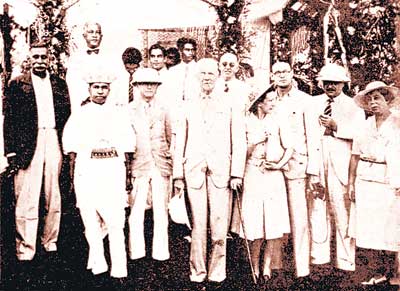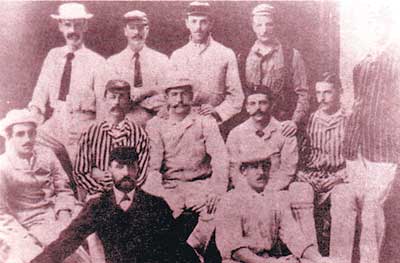New constitution report is released
 |
| The Soulbury Commissioners during a visit to Pelmadulla. Lord Soulbury and Sir Frederick Rees are in the middle with F. J. Burrows behind them. On the extreme left is
D. S. Senanayake. |
Sixty two years ago, on October 9, 1945, a significant event in the political history of Sri Lanka occurred. It was on that day that the Report of the Commission on Constitutional Reform, commonly referred to as the Soulbury Commission Report (Viscount Soulbury being its head) was released simultaneously in England and Ceylon (as
Sri Lanka was then called).
The three-member Commission (Sir J. F. Rees and Sir F. J. Burrows were the other two members with Trafford Smith as secretary) was in the country from December 1944 until April 1945, during which time, memoranda were called for from the public and 20 public sessions were held.
The main recommendation of the Commission was the establishment of a constitution based on the one in England (popularly known as the Westminster model) to replace the Donoughmore Constitution which was in force since 1931. The new constitution provided for a Parliament comprising a lower house (House of Representatives with 101 members) and an upper house ( Senate – 30 members) similar to the House of Commons & House of Lords in England, and a Cabinet led by a Prime Minister who was the leader of the party with the largest number of members in the lower house.
The Commission travelled widely throughout the country, acquainted themselves with the life of the people, inspected industries and factories, gained first hand knowledge of the major crops, saw the facilities offered in schools and visited hospitals, maternity and welfare centres.
"We had the good fortune to see many of the ancient monuments and historic temples to be found in all parts of the island, including the 'buried cities' of Anuradhapura and Polonnaruwa. Throughout these visits and inspections, all classes of the community received us with marked courtesy and kindness, and everywhere we were overwhelmed with hospitality," the Commission wrote.
The 160-page report was quite exhaustive and discussed the historical background while three chapters were devoted to the working of the Donoughmore Constitution and the social progress during the period 1931 – 45. The Commission recommended that universal suffrage (everyone over 21 years of age having the right to vote if he or she was a British subject and resident for a short and continuous period in the relevant electoral district) be retained. Then it went on to discuss a number of issues including the minorities, Kandyan problem, immigration, electoral abuses, representation, legislature, executive and public services and the judicial services, and make recommendations where necessary.
Two years later…
Exactly two years after the release of the Soulbury Commission report, on October 8, 1947, the first meeting of the first Cabinet appointed under the new constitution held its first meeting. It was presided over by Prime Minister D. S. Senanayake who headed the cabinet consisting of 14 ministers.
|


